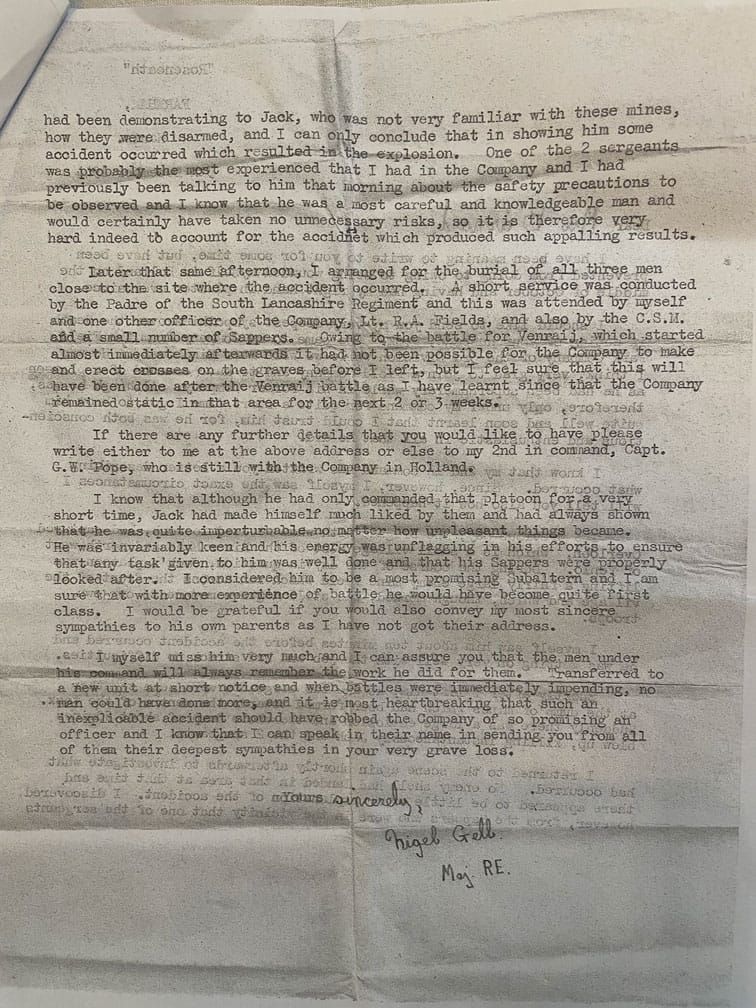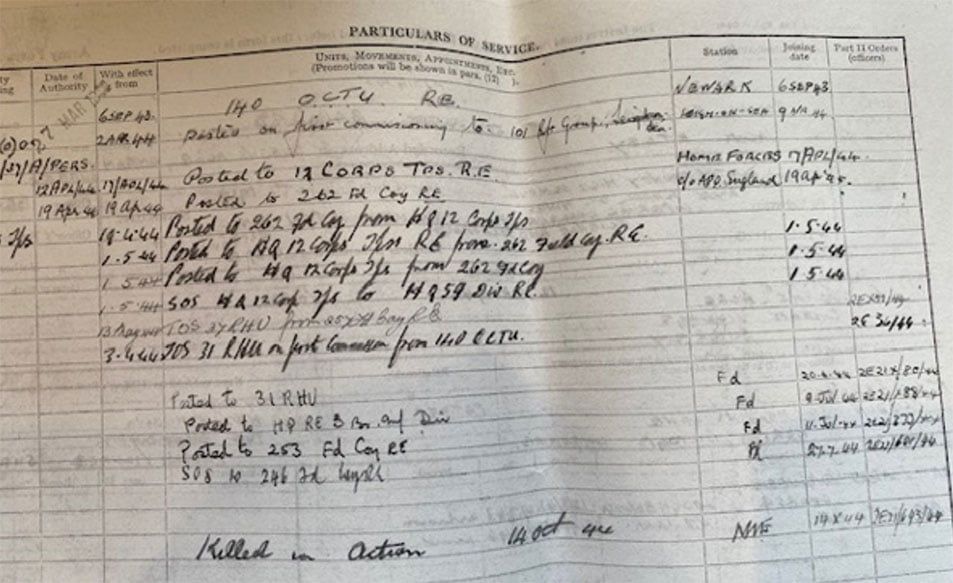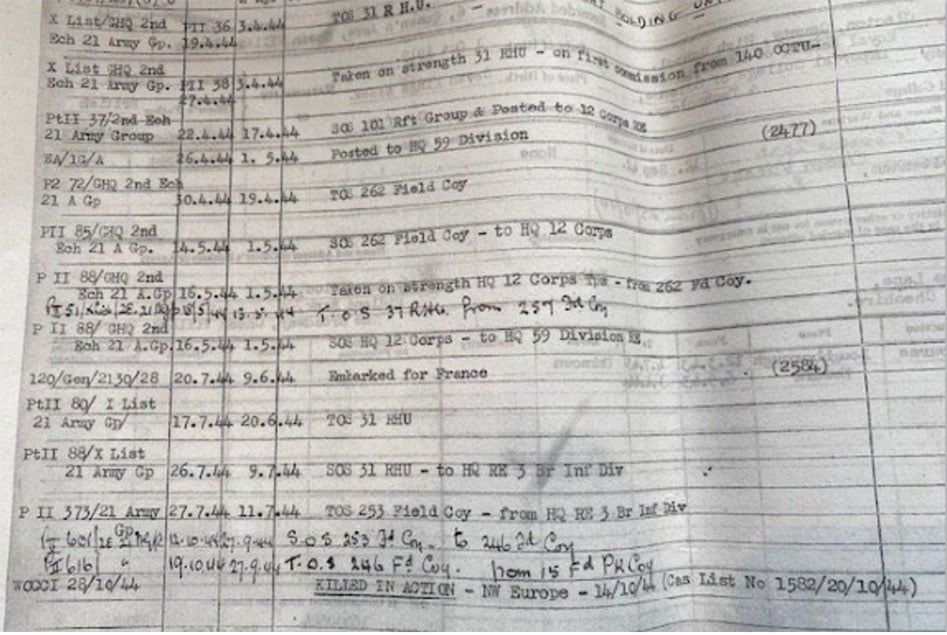Barnard | Jack Kitley
- First names
Jack Kitley
- Age
25
- Date of birth
1919
- Date of death
14-10-1944
- Service number
314365
- Rank
Lieutenant
- Regiment
Royal Engineers, 246 Field Coy.
- Grave number
III. C. 13.

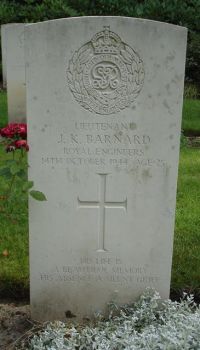
Author Geert de Kruijf
Biography
Jack was born on 1 October 1919 in Seven Kings, Essex, the son of Sidney George and Elsie Barnard. He had two brothers. They lived at 39 Hollins Lane, Marple Bridge, Cheshire. His father, like his grandfather and one of his brothers, was a dentist.
He married Peggy Ina Brown on 12 September 1942 at St.Dunstan’s Church in Cheam Surrey. They had one daughter, Susan, born on 2 February 1945.

His education

He attended Clacton High School in Essex. In 1937, he attended the Royal School of Mines. This school was founded in 1851 as the Government of Mines and Science Applied to the Arts and renamed the Royal School of Mines in 1863, a state educational institution for mining science in London. In 1907, it became part of Imperial College and now houses the Earth Science and Engineering and Materials departments of Imperial College.
In 1941, he obtained a ‘first-class A.R.S.M. in mining’ and ‘The London B.Sc. (Engineering)’. A.R.S.M. stands for Associate of the Royal School of Mines. It is a degree awarded by Imperial College London and is considered equivalent to a bachelors degree in mining. He took a job with Messrs J.Cochran & Co in Wolverley, Worcestershire, and in 1942 was employed by Geevor Tin Mines Ltd. Cornwall. He left there for the ‘Royal Engineers’ in 1943 and became an officer in 1944.
Military career
Using the ‘Particulars of service’, a registration list, it was possible, with the help of outside experts, to make a rough survey of the units in which he was posted.
He was posted to the 21st Army Group GHQ (general head quarters/general headquarters.
The 21st Army Group was the highest unit that everything fell under before and during the liberation of Normandy.
He was then shifted to units that had a demand for officers or to introduce him to the various units.
On 17 April 1944 to 12 Corps (corps under 21st Army Group).
On 19 April 1944 to 262 Field Company Royal Engineers. 262 was a unit under 59th Division HQ.
On 1 May 1944 to HQ 59 Division (division that made up 12 Corps with many units).
Finally on 13 May 1944 briefly to 257 Field Company of 59th Division.
He is probably part of the 257 Field Company when he goes to Normandy on 9 June 1944.
From there, he moves to the 3rd Infantry Division. There he is part of 253 Field Company assigned to 3rd Division Headquarters.
He then passes internally through the 3rd Division to other units (of course, they had daily losses and needed some shifting to stay at strength).
From the 253rd Field Company, he moves to the 246th Field Company on 27 September 1944 and there he finally finds his death near Overloon on 14 October 1944. His death is not recorded in the ‘Particulars of service’ until 19 October 1944.
He fell in Overloon on or near the Stevensbeekseweg. At the same time as him, sergeants E.H. Rees and T.J. Watts died. All three are buried at Overloon War Cemetery.
Jack was killed in an accident in which mines were exploding. His commander explains in a letter dated 5 December 1944 to Jack’s family exactly what happened. A fatal accident in which 3 soldiers were killed instantly. Read the exact facts in his letter below.
Bryan Guy, veteran and platoon member also describes the events years later.
“It was at the time that we first encountered a new type of German Anti-tank mine, we called “Riegl”-mines. A long, sandy coloured boxed with enormous power.
In this corner of Overloon, hundreds of these mines had been lifted and stacked everywhere, in ditches, on top of the ground, all over the place.”
While we were there, enemy fire was coming down on us. It was very dangerous, the place was infested with mines. An officer told us to wait for a reliable man who would try to take this new mine apart, because we had no idea if they were booby trapped or had any ‘anti handling devices’.
After talking the matter over for a while, the officer and me went off with my motor-bike. After a couple of seconds, from behind us there was a huge explosion. We immediately dragged the bike round and set off back, only to find that all the mines had blown up and everyone with it.
We do not know if Sgt. Watts and Sgt. Rees decided to investigate the mines themselves, or if (more likely) they had been hit with a mortar bomb that had set off all the mines. When we arrived they were all dead, and all had been killed instantaneously.
Death often comes quickly and unexpectedly. Our friends that we had been talking to minutes before, had gone.”
The men were temporary buried nearby in a field grave. This grave was recorded with the coordinates 757323 on ‘Map St. Anthonis, Holland, image 11 of 55’ (GPS: latitude: 51° 34‘ 34’ N/longitude 5° 56’38’ E).
He is mentioned only twice in his company’s war reports. On 13 October he takes command of the 2nd platoon and on 14 October his death is reported.
Jack Barnard is buried in grave III. C. 13. Edward Rees lies in grave III.C.14 and Thomas Watts in grave III. C. 12.
Poem by Bryan Guy
Dedicated to all those young men that never came home. From the Fields of Normandy I bring back many memories. I leave many friends, which include Jack Barnard, Edward Rees and Thomas Watts
Les Fleurs de Normandie.
On Norman soil, they fought and died.
Now young men’s graves in rows abound.
In Mother Earth’s arms, now sanctified,
The fragrant flowers of our youth are found.
And yet, to rise again, as in a distant song.
Small voices that call, in dead of night.
Fleeting figures only in our dreams belong.
Alas, they fade, in dawn’s bright light.
I see them yet, a sad, forgotten throng.
Shadowed, lost faces, marching on.
Over dusty roads, and high golden corn.
The call of long lost friends are borne.
We must not forget, the flowers of our days,
Lest they lay unquiet, in numbered graves.
For we lived, and loved, and life was sweet.
Still yet, for us, awaits our last retreat.
Flowers of our youth, now long since past.
Our sweet autumn days are fading fast.
We, who are left, flowered in our prime.
Enjoyed golden moments, on borrowed time.
Remember our friends, who passed this way.
For all our tomorrow’s, they gave their today’s,
On Utah and Omaha, Juno, Sword and Gold.
Oh! Dear Lord! See that they grow not old.
Brian Guy.
June 1944/2010
Family photo’s



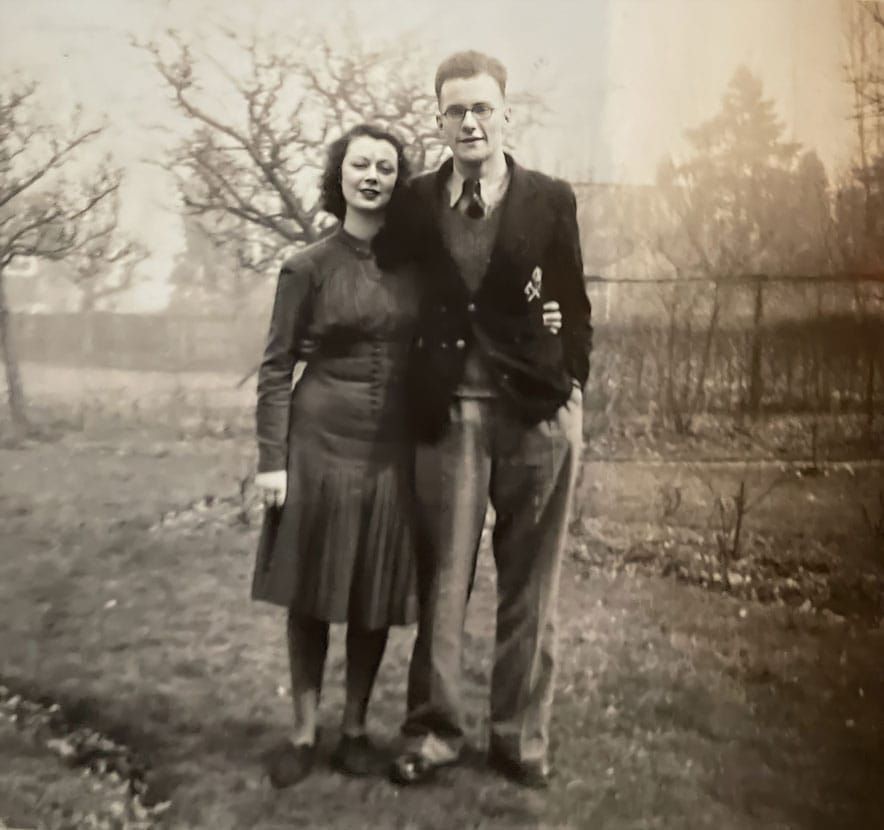




Documents
Sources and credits
Susan Spears
Andy en Karen Barnard
Ernest Donders
Jeroen Koppes STIWOT
Bryan Guy veteran and platoon member
http://ww2talk.com/index.php?threads/for-all-my-lost-friends.25274/
http://www.6thcorpscombatengineers.com/BrianGuy.htm
Research Geert de Kruijf, Anny Huberts, Piet Peters

